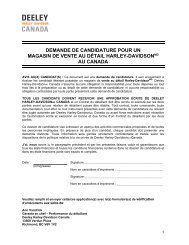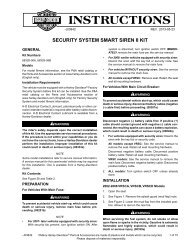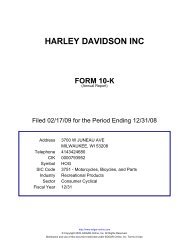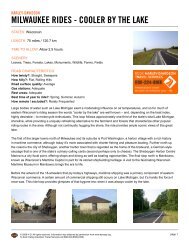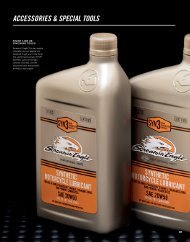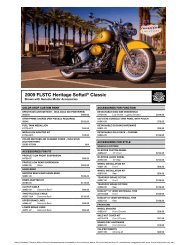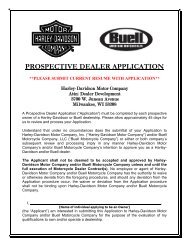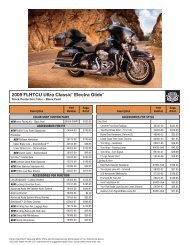SUSTAINABILITY STRATEGY REPORT 2012 - Harley-Davidson
SUSTAINABILITY STRATEGY REPORT 2012 - Harley-Davidson
SUSTAINABILITY STRATEGY REPORT 2012 - Harley-Davidson
You also want an ePaper? Increase the reach of your titles
YUMPU automatically turns print PDFs into web optimized ePapers that Google loves.
<strong>SUSTAINABILITY</strong><br />
<strong>STRATEGY</strong> <strong>REPORT</strong><br />
<strong>2012</strong><br />
WE Preserve and Renew the Freedom to Ride
Contents<br />
03. Section One: Introduction<br />
06. Section Two: Reducing Our Environmental Impact<br />
07. Waste Reduction and Recycling<br />
08. Water Use Improvements<br />
09. Energy Consumption Reductions<br />
10. Other Projects<br />
11. Section Three: Improving Our Social Impact<br />
13. Section Four: Emissions Data<br />
15. Direct Emissions from Manufacturing 2004 – <strong>2012</strong><br />
16. Section Five: Regulatory and Strategic Analysis<br />
17. Federal Greenhouse Gas Emissions Regulations<br />
19. State Greenhouse Gas Emissions Initiatives<br />
20. International Developments<br />
20. Commercial Risks and Challenges
section<br />
One<br />
Introduction<br />
3
“For <strong>Harley</strong>-<strong>Davidson</strong>, sustainability means thinking differently to preserve<br />
and renew our Company for long-term success. We are passionate about<br />
future generations of riders sharing the <strong>Harley</strong>-<strong>Davidson</strong> experience that<br />
we enjoy. Our purpose is clear: We fulfill dreams of personal freedom. And<br />
from that our Sustainability vision is simple: We preserve and renew the<br />
freedom to ride.”<br />
KEITH WANDELL, CHAIRMAN, PRESIDENT & CEO – HARLEY-DAVIDSON, INC.
S USTAINABILITY IS ONE OF OUR FOUR STRATEGIC PILLARS, ALONG WITH<br />
GROWTH, LEADERSHIP DEVELOPMENT AND CONTINUOUS IMPROVEMENT.<br />
<strong>Harley</strong>-<strong>Davidson</strong> Sustainability:<br />
We Preserve and Renew the Freedom to Ride<br />
• We are committed to preserving and renewing our company and experience for<br />
future generations of global customers through shared value creation.<br />
• We seek ways to improve the quality of life, the strength and vibrancy of<br />
local communities, and the health and welfare of our planet.<br />
• We ride with our customers and continually find ways to reduce waste,<br />
energy consumption and emissions.<br />
• We support growing the sport of motorcycling with an emphasis on rider<br />
and community safety, preservation of riding destinations around the world,<br />
and community development.<br />
Our sustainability vision encourages all <strong>Harley</strong>-<strong>Davidson</strong> 1 employees to understand and embrace the challenge<br />
and opportunity of sustainability. We want future generations to enjoy the riding experiences we enjoy, and<br />
delivering those experiences means preserving and renewing our brand for the future, just as we have done<br />
repeatedly for 110 years.<br />
<strong>Harley</strong>-<strong>Davidson</strong> recognizes that corporations today need to be more resourceful and responsible with respect<br />
to environmental and social impacts. For our operations, we seek to go beyond environmental compliance to<br />
take actions that reduce energy and water consumption, waste generation and related greenhouse gas (GHG)<br />
emissions associated with our manufacturing facilities. For purposes of this report, we provide information<br />
about our direct (Scope 1-combustion of natural gas and other fuels) and our indirect (Scope 2-electricity)<br />
GHG emissions from our U.S. manufacturing plants.<br />
Beyond minimizing the environmental impacts of our manufacturing operations, <strong>Harley</strong>-<strong>Davidson</strong> is taking a<br />
number of steps to develop a comprehensive approach to sustainability and the transition to a lower-carbon<br />
economy. During <strong>2012</strong> we examined our value chain and identified areas of focus for environmental and<br />
social sustainability across our entire business. Our integrated approach to embedding sustainability across<br />
the company is led by the Corporate Strategy and Sustainability team with oversight from the Sustainability<br />
Committee of our Board of Directors.<br />
1<br />
<strong>Harley</strong>-<strong>Davidson</strong>, Inc. is the parent company of <strong>Harley</strong>-<strong>Davidson</strong> Motor Company and <strong>Harley</strong>-<strong>Davidson</strong> Financial Services. <strong>Harley</strong>-<strong>Davidson</strong> Motor<br />
Company produces heavyweight custom, cruiser and touring motorcycles and offers a complete line of <strong>Harley</strong>-<strong>Davidson</strong> motorcycle parts, accessories, riding<br />
gear and apparel, and general merchandise. <strong>Harley</strong>-<strong>Davidson</strong> Financial Services provides wholesale and retail financing, insurance, extended service and<br />
other protection plans and credit card programs to <strong>Harley</strong>-<strong>Davidson</strong> dealers and riders in the U.S., Canada and other select international markets.<br />
5
section<br />
Two<br />
Reducing Our<br />
Environmental Impact<br />
6
<strong>Harley</strong>-<strong>Davidson</strong> is continually working to reduce the environmental impact of our manufacturing and other<br />
operations, including on-going efforts to reduce waste and increase recycling, and reduce water use and<br />
energy consumption. This section highlights a handful of projects in our U.S. facilities in <strong>2012</strong>.<br />
Waste Reduction and Recycling<br />
<strong>Harley</strong>-<strong>Davidson</strong> manufacturing facilities aspire to reach zero landfill status. We have established a goal of less<br />
than 10% waste to landfill for 2013 for our US manufacturing operations, compared to our performance of less<br />
than 13% in <strong>2012</strong>. Our efforts in <strong>2012</strong> to achieve this goal included:<br />
Our Kansas City vehicle and powertrain assembly facility entered into a waste-to-energy agreement in late<br />
2011 with Systech/LaFarge North America (a national Portland cement manufacturer) in Sugar Creek,<br />
Missouri. Wastes approved by Systech are used as fuel in the kilns at the cement manufacturing site and<br />
any remaining ash is incorporated into the cement. As of December <strong>2012</strong>, all plant trash is also being sent to<br />
Systech/LaFarge, which has reduced the plant’s amount of waste going to landfill from approximately 20% to<br />
less than 6%.<br />
Our Pilgrim Road powertrain operations in Menomonee Falls, Wisconsin, reduced waste and diverted more of<br />
that waste from landfill in <strong>2012</strong> through both new recycle and re-use streams, resulting in a waste to landfill<br />
percentage of 5.9%. Approximately eight pounds per unit (engine) less waste was generated in <strong>2012</strong> than in<br />
2011. This was accomplished in part by using a chip wringer to recover and recycle coolant on-site. Over the<br />
year coolant disposal fell 28%.<br />
The Pilgrim Road plant also reduced the amount of trash sent to landfill by 24% through increased recycling.<br />
A new container system was introduced that gives clear messaging on where common items should go. As<br />
a result, the amount of recycling increased to nearly 10,000 pounds in <strong>2012</strong>, with the average amount of<br />
mixed recyclables increasing from around 680 lbs per month at the beginning of the year to an average of<br />
800 lbs per month by the end of the year. In addition, the Pilgrim Road facility sent approximately four tons<br />
of compostable material from the cafeteria to Growing Power, an urban farm. (And the <strong>Harley</strong>-<strong>Davidson</strong><br />
Museum’s restaurant began purchasing locally grown produce from Growing Power in <strong>2012</strong>.)<br />
7
In <strong>2012</strong>, our vehicle operations in York, Pennsylvania, expanded the<br />
plastics recycling program resulting in an increase of 13.16% or 3.81<br />
tons over 2011 levels. The York facility recycled a total of 32.77 tons of<br />
plastic in <strong>2012</strong>.<br />
The York facility also began bringing paint sludge to a waste-to-energy<br />
facility in <strong>2012</strong>. Previously this sludge was stabilized (solidified) and sent<br />
to a landfill.<br />
Most significantly, in <strong>2012</strong> we completed the restructuring/consolidation<br />
of the York facility. The project eliminated numerous waste streams from<br />
our operations. This resulted in the reduction of hazardous waste by 52%<br />
or 313 tons, residual waste by 68% or 7,075 tons and universal waste by<br />
44% or 3 tons. Overall waste was reduced by 67% or 7,391 tons.<br />
WATER USE IMPROVEMENTS<br />
In <strong>2012</strong>, the Pilgrim Road facility reduced water intake by 1,166,000 gallons. The water reductions were the<br />
result of the full implementation of a new powder-coat system. (The old system was phased out in spring of<br />
<strong>2012</strong>.) The new system uses far less water due to a key change: the new system only pulls water when it needs<br />
it versus using a continuous flow of water, which spilled unused water down the drain. The new system uses<br />
sensors that automatically take water in as needed and shut off the flow when not needed.<br />
In October <strong>2012</strong>, the York facility implemented a project to redirect the reverse osmosis (RO) system’s wastewater<br />
from the wastewater treatment plant to the sanitary sewer. It was estimated that the RO system generated<br />
between 5 to 10 gpm of wastewater during operation. The flow was originally redirected at about 50% and at<br />
year end 100%. The estimated flow during that time frame was approximately 8,000 gpd. This reduced our use<br />
of treatment chemicals (sulfuric acid and sodium hydroxide) in the wastewater treatment plant. Based on the<br />
volume of treated wastewater, this resulted in an estimated reduction of 4.3 gallons chemicals per day (19%).<br />
8
ENERGY CONSUMPTION REDUCTIONS<br />
<strong>Harley</strong>-<strong>Davidson</strong>’s U.S. manufacturing sites establish annual targets for energy consumption and seek year over<br />
year improvement. During <strong>2012</strong>, activities to reduce our energy consumption included:<br />
The completion of a new powder coat line that uses residual heat from baking ovens to warm the water for<br />
the powder coat washers has increased energy efficiency at the Pilgrim Road facility. The conversion of the<br />
powdercoat operation from two lines to the new single system has reduced natural gas consumption by 32%. In<br />
addition, Pilgrim Road also installed a new chilled water system in the first quarter of <strong>2012</strong>, and the facility has<br />
been diligently repairing compressed air leaks throughout the entire plant.<br />
York vehicle operations successfully shed power during the summer of <strong>2012</strong> to conserve electricity. HVAC units<br />
were shut down on peak demand days which conserved electricity during the summer heat. Power shedding of<br />
electricity was 0.5 MKw for six hours. This was done on six different days and supported demand management<br />
efforts of the local utility.<br />
In addition, changes in the operating parameters for the paint ovens now allows them to be shut off during nonproduction<br />
times (weekends and holidays) saving natural gas usage. This resulted in an average reduction in<br />
natural gas consumption of 61.5%.<br />
The York restructuring project noted above also resulted in a reduction in energy use. Electricity was reduced by<br />
54% and natural gas was reduced by 67% comparing <strong>2012</strong> data to 2009 data. (2009 was the last full year prior<br />
to restructuring/consolidation activities and <strong>2012</strong> data was the first year of full production after consolidation.)<br />
9
OTHER PROJECTS<br />
In <strong>2012</strong> the York operations continued to reduce air pollutant generating activities on forecasted Air Quality<br />
Action Days. Examples include:<br />
• Reduced motorcycle audits by 50% without impacting quality<br />
• Reduced Roll Test miles by 33%<br />
• Limited usage of hand held gasoline-powered equipment<br />
Some general tips provided to employees and contractors on-site on Air Quality Action Days were:<br />
• Refuel vehicles after dark. Avoid spilling gasoline. Stop fueling when pump shuts off automatically. Properly<br />
maintain vehicles.<br />
• Conserve energy. Don’t overcool homes. Turn off lights and appliances when not in use. Wash clothes and<br />
dishes only in full loads.<br />
• Limit daytime driving. Consider carpooling or taking public transportation.<br />
• Limit outdoor activities (lawn mowing or sports) to the evening hours.<br />
The York Communications team provides these announcements via emails and the internal TV system. The<br />
Security staff updates Air Quality Actions signs posted at guard gates on Air Quality Action Days.<br />
10
section<br />
Three<br />
Improving Our<br />
Social Impact<br />
11
Improving Our Social Impact<br />
Through The <strong>Harley</strong>-<strong>Davidson</strong> Foundation, corporate giving and employee volunteer activities, we seek to<br />
create positive social impact in the areas of education, health and the environment in communities that are<br />
home to H-D operations and to expand the reach and impact of customers and dealers.<br />
In support of these focus areas, <strong>Harley</strong>-<strong>Davidson</strong>’s <strong>2012</strong> corporate charitable giving topped $4.5 million in<br />
grants and merchandise. Among the recipients:<br />
• Milwaukee-based New Threads of Hope received more than $1 million in discontinued apparel and<br />
accessories to be distributed among various agencies throughout southeastern Wisconsin.<br />
• United Way of Greater Milwaukee received $284,000 toward its outreach and support programs.<br />
• As part of a four-year, $1 million grant, Disabled American Veterans received $250,000 to help support<br />
<strong>Harley</strong>’s Heroes, a program to help veterans secure their military benefits.<br />
• A portion of the proceeds from the sale of <strong>Harley</strong>-<strong>Davidson</strong>’s Pink Label Collection of apparel and accessories<br />
goes to breast cancer organizations, totaling nearly $200,000 in <strong>2012</strong>.<br />
• Milwaukee Habitat for Humanity received a $200,000 grant for its Neighborhood Revitalization Initiative<br />
focused on the Washington Park area (near our corporate headquarters).<br />
Additionally, since 1980, the <strong>Harley</strong>-<strong>Davidson</strong> family of customers, dealers, suppliers and employees has<br />
raised more than $84.2 million to aid research and program services for children and adults with muscular<br />
dystrophy. The funds raised support life-saving research, comprehensive medical care for children and adults<br />
with neuromuscular disease, and MDA summer camps.<br />
12
section<br />
Four<br />
Emissions Data<br />
13
H ARLEY-DAVIDSON MOTOR COMPANY OPERATES FOUR U.S.<br />
MANUFACTURING FACILITIES AND ONE RESEARCH AND DEVELOPMENT<br />
FACILITY, AS OF DECEMBER 31, <strong>2012</strong>:<br />
<strong>Harley</strong>-<strong>Davidson</strong> Operations<br />
in Tomahawk, Wisconsin<br />
(Tomahawk facility)<br />
<strong>Harley</strong>-<strong>Davidson</strong> Powertrain Operations in<br />
Menomonee Falls, Wisconsin<br />
(Pilgrim Road facility)<br />
<strong>Harley</strong>-<strong>Davidson</strong> Vehicle Operations<br />
in York, Pennsylvania (York facility)<br />
<strong>Harley</strong>-<strong>Davidson</strong> Vehicle<br />
and Powertrain Operations<br />
in Kansas City, Missouri<br />
(Kansas City facility)<br />
Willie G. <strong>Davidson</strong> Product Development<br />
Center in Wauwatosa, Wisconsin<br />
(Product Development Center)<br />
These facilities manufacture motorcycle engines, transmissions and components and<br />
perform final assembly. They range in size from approximately 100,000 square feet<br />
at the Tomahawk facility to almost 1,000,000 square feet at the Pilgrim Road facility.<br />
(<strong>Harley</strong>-<strong>Davidson</strong> also operates two low-volume assembly facilities in Brazil and India.)<br />
The majority of GHG emissions associated with <strong>Harley</strong>-<strong>Davidson</strong> operations are related<br />
to energy use at these U.S. facilities (natural gas and electricity). The combined<br />
consumption of energy at these facilities resulted in approximately 36,987 metric<br />
tons of direct (Scope 1) GHG emissions in <strong>2012</strong> – 5,165 metric tons less than 2011.<br />
In addition, these facilities used 183,569,322 KWH of electricity, which corresponds<br />
to124,782 metric tons CO 2<br />
e of indirect (Scope 2) GHG emissions – 5,736 metric tons<br />
less than 2011.<br />
<strong>Harley</strong>-<strong>Davidson</strong> is continually working to reduce the environmental impact of its<br />
manufacturing facilities, including ongoing efforts to reduce waste generation, water<br />
and energy use and associated GHG emissions. As part of this effort, <strong>Harley</strong>-<strong>Davidson</strong><br />
Motor Company has compiled Scope 1 GHG data for the years 2004 through <strong>2012</strong> for<br />
our manufacturing facilities. 2<br />
2<br />
<strong>Harley</strong>-<strong>Davidson</strong> previously owned facilities associated with Buell Motorcycle Company. These operations were closed in<br />
late December 2009 and are included in the GHG data through 2009. International facilities are not yet included in the<br />
GHG data.<br />
14
DIRECT EMISSIONS<br />
FROM MANUFACTURING 2004–<strong>2012</strong><br />
<strong>Harley</strong>-<strong>Davidson</strong> follows the GHG Protocol Corporate Standard. The protocol was prepared by a multistakeholder<br />
partnership of businesses, nongovernmental organizations, governments, and others convened by<br />
the World Resources Institute and the World Business Council for Sustainable Development.<br />
<strong>Harley</strong>-<strong>Davidson</strong> reports information on emissions of three GHGs: carbon dioxide (CO 2<br />
), methane (CH 4<br />
),<br />
and nitrous oxide (N 2<br />
O), all quantified as CO 2<br />
equivalents (CO 2<br />
e). Our GHG data consists of direct emission<br />
sources (Scope 1) from manufacturing and research and development facilities. As of 2011, we also report<br />
our GHG emissions from indirect sources (i.e., purchased electricity (Scope 2)). Indirect value chain emissions<br />
from transportation, purchased materials and the like (Scope 3) are not currently evaluated. GHG estimates for<br />
emissions from operation of individual motorcycles are also not included in the information reported here.<br />
The primary GHG in our Scope 1 data are CO 2<br />
emissions from combustion of natural gas, gasoline and fuel<br />
oil. As shown in Figure 1, <strong>Harley</strong>-<strong>Davidson</strong> Motor Company decreased its annual GHG emissions from 79,232<br />
metric tons in 2004 to 36,987 metric tons in <strong>2012</strong>. On a per motorcycle basis, we have gone from a high<br />
during this timeframe of 0.25 metric tons CO 2<br />
e to approximately 0.15 metric tons CO 2<br />
e (Scope 1).<br />
As a result of decreased motorcycle production, <strong>Harley</strong>-<strong>Davidson</strong>’s energy reduction projects, reductions<br />
in the operational footprint at our Wisconsin powertrain operations and York facility, and other factors, GHG<br />
emissions have been reduced in our manufacturing operations by a total of 148,160 metric tons over the<br />
2005-<strong>2012</strong> time period, as compared to what would have been emitted had Scope 1 GHG emissions<br />
remained at 2004 levels.<br />
HARLEY-DAVIDSON MOTOR COMPANY<br />
SCOPE 1 GREENHOUSE GAS EMISSIONS<br />
CO 2<br />
e<br />
2<br />
0<br />
0<br />
4<br />
2<br />
0<br />
0<br />
5<br />
2<br />
0<br />
0<br />
6<br />
2<br />
0<br />
0<br />
7<br />
2<br />
0<br />
0<br />
8<br />
2<br />
0<br />
0<br />
9<br />
2<br />
0<br />
1<br />
2<br />
0<br />
1<br />
2<br />
0<br />
1<br />
0 1 2<br />
15
section<br />
Five<br />
Regulatory and<br />
Strategic Analysis<br />
16
Regulation designed to address climate change, particularly GHGs like CO 2<br />
, is expected to increase<br />
significantly in the next five to 10 years. While regulations at the state, federal and international levels<br />
remain in flux, proposed and final regulations have the potential to affect the motorcycle industry.<br />
Notably, in December 2011 at the United Nations sponsored meeting in Durban, South Africa, almost 200<br />
countries agreed to draft a new global emissions treaty by 2015. The three largest emitters of greenhouse<br />
gases – the United States, China and India – all agreed to be legally bound to reduce their emissions.<br />
This section describes federal GHG regulations, as well as those in Wisconsin, Pennsylvania and Missouri,<br />
where <strong>Harley</strong>-<strong>Davidson</strong> has manufacturing facilities. International initiatives, including in the European Union<br />
and Japan, are also discussed due to their leading impact on regulatory trends.<br />
FEDERAL GREENHOUSE GAS EMISSIONS REGULATIONS<br />
President Obama has requested that Congress develop a plan to further cut GHG emissions and<br />
indicated he will use executive powers alone if it does not. Nonetheless, no federal legislation regulating<br />
greenhouse gas emissions has yet been enacted in the U.S. Past proposed bills have contained<br />
vehicle performance standards applicable to motorcycles, along with a cap-and-trade system for<br />
GHG emissions. Such legislation could require changes to <strong>Harley</strong>-<strong>Davidson</strong>’s manufacturing facilities.<br />
The U.S. EPA has taken direct action to regulate GHG emissions, specifically issuing rules to require<br />
permitting of GHG emissions and to restrict GHG emissions from new light-duty vehicles and new<br />
power plants (motorcycles are not included within these rules).<br />
17
U.S. EPA Reporting Rule<br />
In October 2009, the U.S. EPA issued a reporting rule requiring certain sources begin tracking emissions<br />
for six GHG pollutants, including carbon dioxide (CO 2<br />
), methane (CH 4<br />
), and nitrous oxide (N 2<br />
O), beginning<br />
January 1, 2011, with the first annual reports due to U.S. EPA by March 31, <strong>2012</strong>. The rule specifically<br />
identified motorcycle manufacturing facilities as subject to the reporting rule on a per facility basis if emissions<br />
from stationary fuel consumption sources (e.g., industrial boilers) at a facility are 25,000 metric tons of carbon<br />
dioxide equivalent (CO 2<br />
e) or more. Currently, no <strong>Harley</strong>-<strong>Davidson</strong> facilities exceed this threshold.<br />
Engine emissions reporting was required for CO 2<br />
beginning with model year 2011, with CH 4<br />
added for<br />
model year <strong>2012</strong> and N 2<br />
O for model year 2013. This reporting is folded into the existing engine emissions<br />
certification process under the Clean Air Act (CAA). Engine manufacturers have been tracking CO 2<br />
emissions<br />
but were previously not required to report them.<br />
U.S. EPA Endangerment Finding<br />
In December 2009, U.S. EPA’s Administrator signed two findings for GHGs—the “Endangerment Finding”<br />
and the “Cause and Contribute Finding”—that apply to motor vehicles (including motorcycles). These<br />
findings establish the basis for the U.S. EPA’s position that GHGs are a threat to public health and welfare.<br />
The immediate effect of the findings was minimal, as they imposed no substantive requirements on their own.<br />
However, they were the necessary precursor to U.S. EPA regulation of GHG emissions from motor vehicles.<br />
Legal challenges to the findings by several states and industry groups were unsuccessful (Coalition for<br />
Responsible Regulation, et al. v. EPA, 684 F.3d 102 (D.C. Cir. <strong>2012</strong>)).<br />
U.S. EPA and NHTSA Tailpipe Rule<br />
Following issuance of the findings, U.S. EPA and the National Highway Traffic Safety Administration (NHTSA)<br />
issued a light-duty vehicle rule (the “Tailpipe Rule”) that, while not applicable to motorcycles, was the first<br />
federal rulemaking regulating GHG emissions. The Tailpipe Rule faced, and overcame, the same challenges<br />
as the Endangerment Finding and the Cause and Contribute Finding in Coalition for Responsible Regulation.<br />
In October <strong>2012</strong> the second phase of the Tailpipe Rule was issued with 2025 targets for light duty vehicles<br />
of 150g/km CO 2<br />
and 50mpg. The model underlying this rulemaking is not readily applicable to motorcycles,<br />
however, and we will continue to monitor and comment as appropriate on regulatory developments. U.S. EPA<br />
data indicate that the contribution of motorcycles to CO 2<br />
from all mobile sources is on the order of 0.1%.<br />
U.S. EPA Tailoring Rule<br />
Due to the definitional structure of the CAA, once GHGs are regulated as pollutants under the mobile source<br />
provisions of the CAA, it is U.S. EPA’s position that those same “pollutants” are subject to regulation under<br />
the permitting requirements for stationary sources. Consequently, all major stationary sources of GHGs (e.g.,<br />
emissions sources at power plants, manufacturing facilities, etc.) would be subject to permitting obligations,<br />
including emission control requirements for new and modified sources. However, U.S. EPA issued a “Tailoring<br />
Rule” to significantly increase the applicability thresholds for large sources. (Challenges to the Tailoring Rule<br />
were dismissed in Coalition for Responsible Regulation on the basis of lack of jurisdiction.) The practical effect<br />
of the Tailoring Rule is that new and modified sources will have to continue to assess GHGs as part of their<br />
new source review permitting process. This will potentially subject <strong>Harley</strong>-<strong>Davidson</strong>’s manufacturing facilities<br />
to permitting and emissions control requirements at some point in the future.<br />
18
STATE GREENHOUSE GAS EMISSIONS INITIATIVES<br />
<strong>Harley</strong>-<strong>Davidson</strong> operates manufacturing facilities in three states – Wisconsin, Missouri and Pennsylvania.<br />
Wisconsin<br />
On December 28, <strong>2012</strong>, U.S. EPA published a proposed rule revising, in two key respects, Wisconsin’s State<br />
Implementation Plan (SIP) under the Clean Air Act. First, the rule would approve revisions to Wisconsin’s<br />
Prevention of Significant Deterioration (PSD) program to establish emissions thresholds consistent with the<br />
Tailoring Rule. Second, the rule defers until July 21, 2014, the application of the PSD permitting requirements<br />
to CO 2<br />
emissions that are generated from bioenergy and biogenic stationary sources.<br />
While Wisconsin is a member of the Midwest Greenhouse Gas Reduction Accord, the only outcome of that<br />
Accord has been a model cap-and-trade rule released in 2010 that would apply to sources emitting more than<br />
25,000 metric tons of CO 2<br />
e. Wisconsin’s only regulatory requirement is for facilities emitting 100,000 tons or<br />
more per year of CO 2<br />
to report those emissions to the Wisconsin Department of Natural Resources. No <strong>Harley</strong>-<br />
<strong>Davidson</strong> facilities exceed this threshold.<br />
Missouri<br />
Missouri did not sign the Midwest Greenhouse Gas Reduction Accord, and has not considered greenhouse gas<br />
regulations or legislation.<br />
Pennsylvania<br />
In past years, Pennsylvania has pursued several means of regulating GHG emissions. In 2008, it enacted<br />
the Pennsylvania Climate Change Act requiring reports on the impact of climate change as well as any<br />
economic opportunities presented by reduction of GHG emissions. In 2009, pursuant to the Climate Change<br />
Act, the Pennsylvania Department of Environmental Protection (PADEP) released its Final Climate Change<br />
Action Plan, which establishes a statewide greenhouse gas inventory and identifies 52 specific work plans<br />
(recommendations) to mitigate greenhouse gases 30% below 2000 levels by the year 2020. Some of these<br />
work plans propose implementation of best management practices to improve energy efficiency for natural<br />
gas and electricity consumption within the industrial sector. As these work plans wind their way through the<br />
regulatory process, they have the potential to subject <strong>Harley</strong>-<strong>Davidson</strong>’s manufacturing facility to permitting<br />
and emissions control requirements at some point in the future.<br />
Pennsylvania is also an “official observer” of the Regional Greenhouse Gas Initiative (RGGI), a cooperative<br />
effort by several Northeast and Mid-Atlantic States to reduce CO 2<br />
emissions through development of a regional<br />
cap-and-trade program, initially applying only to electric power generating facilities.<br />
19
INTERNATIONAL DEVELOPMENTS<br />
<strong>Harley</strong>-<strong>Davidson</strong> motorcycles are sold worldwide and international regulations impact our business. The<br />
European Union (EU) and some Latin American countries have promulgated and are in the process of<br />
implementing CO 2<br />
efficiency and fuel consumption on-vehicle labeling regulations. Also, CO 2<br />
outputs for motor<br />
vehicles in grams per kilometer (g/km) are linked to taxation and registration requirements in Spain.<br />
On November 30, <strong>2012</strong>, the European Parliament and the Council of the European Union reached<br />
an agreement on the approval of new regulations establishing GHG labeling (CO 2<br />
emissions and fuel<br />
consumption) and more stringent emissions targets for motorcycles. Under the new regulations, the emissions<br />
limits established under the Euro IV legislation will become applicable in 2016 for new type approvals and<br />
2017 for all vehicles, and the Euro V limitations will become applicable by 2020 for all new type approvals<br />
and 2021 for all vehicles. Several other markets, including China, India and other Asian and Latin American<br />
markets are now actively considering following or adapting to the direction established by the European Union.<br />
Japan’s End-of-Life Vehicle (ELV) Recycling Law came into force in January 2005. Under this law, automobile<br />
manufacturers are responsible for recovery, recycling and appropriate disposal with respect to automobile<br />
shredder residue, air bags, fluorocarbons and hazardous materials. However, the ELV Recycling Law does<br />
not cover motorcycles. <strong>Harley</strong>-<strong>Davidson</strong> Japan, a subsidiary of <strong>Harley</strong>-<strong>Davidson</strong> Inc., voluntarily launched<br />
a motorcycle recycling program in October 2005. The program was the first of its kind in the automobile<br />
and motorcycle industries and is at no cost to the consumer. The EU also has an ELV directive applicable<br />
to automobiles, and we anticipate that motorcycles will ultimately be included in recycling and end-of-life<br />
directives in the EU and other countries in the future. This will also mandate an appropriate labeling system for<br />
plastics, metals and materials that are readily recyclable.<br />
COMMERCIAL RISKS AND CHALLENGES<br />
Because the implementation of a specific CO 2<br />
regulation could occur in combination with additional reductions<br />
in currently regulated tailpipe emissions (hydrocarbons and NOx for example), rigorous technical challenges<br />
emerge for vehicle manufacturers. Therefore, additional development and research are required to find ways<br />
to simultaneously improve efficiency and reduce CO 2<br />
and other emissions. This may require motorcycle<br />
manufacturers to develop and adapt the types of advanced technologies that are often employed in the<br />
automotive sector. However, as CO 2<br />
emission standards become more rigorous, potential changes to the<br />
products themselves could become more significant requiring new and innovative motorcycle designs.<br />
Concerns over climate change are expected to ultimately lead to regulation of lower tailpipe emission limits<br />
for motorcycles. In addition, energy security and availability and its related costs affect all aspects of <strong>Harley</strong>-<br />
<strong>Davidson</strong>’s manufacturing operations, including our supply chain. This has an adverse effect on the cost<br />
to manufacture motorcycles. We have several facilities with rich histories (some more than 50 years old)<br />
in Wisconsin and Pennsylvania that are located in cold weather areas. We have implemented numerous<br />
improvements at these facilities to reduce energy use and associated operating costs.<br />
Physical risks to our business operations as identified by the Intergovernmental Panel on Climate<br />
Change and other expert bodies include scenarios such as sea level rise, extreme weather conditions and<br />
resource shortages. Extreme weather may disrupt the production and supply of natural gas, a fuel necessary<br />
for the manufacture of our motorcycles. Supply disruptions raise market rates and jeopardize the continuity<br />
of our manufacturing production. <strong>Harley</strong>-<strong>Davidson</strong> has taken numerous steps to minimize the risk of<br />
production interruptions.<br />
20
©2013 H-D. All Rights Reserved.<br />
<strong>Harley</strong>-<strong>Davidson</strong>, <strong>Harley</strong>, H-D, the Bar & Shield logo and others are among the trademarks of H-D U.S.A., LLC.




